文章
巴黎铁塔
2018年02月06日
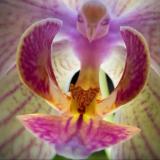

1.浇水太多
如果它的叶子发黑,那很可能就是你给它浇水太多了。很多朋友在养花的时候,都害怕自己的花卉缺水,所以就会不断的去浇水,这样子以来造成水量过多,反而起到了相反的作用。要知道,通常植物在生长的时候,它的根会吸收水分供给给叶子,这样才能让叶子长得更好,可是却不知道,要想让它呼吸,就必须有充足的空气,如果水量太多空气就会变少,这样子就会让根长时间待在过湿的环境下,从而让它缺氧,这样子以来,根就不能很好的供给水分给叶子了,就会让它的叶子发黑。所以浇水一定要适量,万不可过多了。
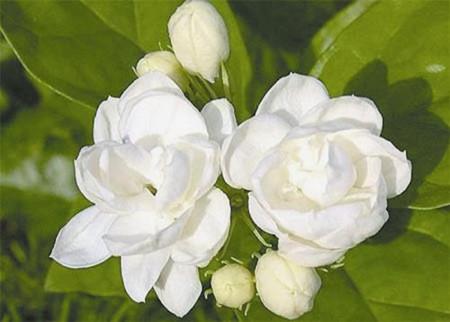
2.病害引起的
茉莉花,容易发生一些病害,例如叶斑病,这是很多花卉都非常惧怕的一种病害。它一旦出现,刚开始会在叶片上面生出很多褐色小斑点,然后在慢慢扩大成圆形或者是不规则形,而且还会让感染上病害的叶子变的稀薄,犹如透明状,慢慢的就会长出来黑色的颗粒物质,这样叶子也就发黑了。
防治方法:如果是这种病害造成的叶子发黑,那就需要及时做出防治。首先我们可以把它的病叶及时剪掉,并且销毁了,然后还要记得少施加一点氮肥,多点磷肥,最后再用药物进行喷洒,就可以起到很好的防治作用。
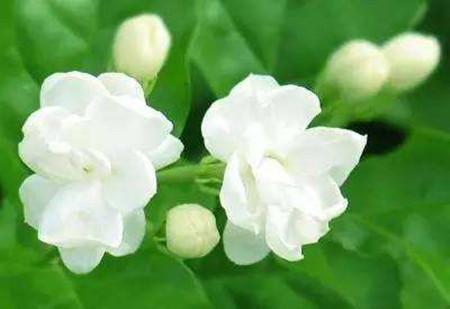
3.施肥过多
同样的有些人,生怕自己的花卉营养不够,于是就去拼命的施肥,给它最多的营养,殊不知,这样子以来就会营养过剩,反而会把它的植株烧坏了,也是会让叶子发黑的。所以一定要控制施肥量。
0
0
文章
权问薇
2018年02月06日


一.有性
1.播种
播种时,应当选择经过精细筛选并且合理处理的种子,按照一定的规格、距离,将种子洒入已经整过的土地里,或者土地不需要耕作,直接播种。
刚播种的种子,在一开始时会吸收大量的水,这时候,种子的鲜重会增加,被称作吸胀。当种子吸收水之后,它的皮会膨胀并且逐渐变软,使得种子可以和它周围的气体进行交换。
在这个过程中,虽然种子没有什么特别大的变化,但实际上其内部非常的活跃,是非常重要的一个阶段,需要适当保温,保证其生长。
等到刚刚生长的根出现后,种子的表皮破裂,子叶和茎出现,种子从土中钻出。这个过程中,种子需要一定的水分、温度以及阳光。

二.无性
1.分株
从这种植物身上,取下一块鳞茎、球茎、块根、根茎,另行栽植,生根后即可成一棵的新植株。这个过程中应当注意温度和水份,防止植物腐烂。
2.嫁接
取一部分带着幼芽的枝条,将这一部分和另一种植物生长正常的枝干连接在一起,保证切口与切口相接,即可长成一株独立的植株。

3.压条
取一根正常的枝条,用小刀在其上面刻一个小孔,将其埋进土地中。等待被埋入土中的部分生长出完整的根部,即可以将两株植物分开,成为独立的两株植物。
4.扦插
去下这种植物的一部分,将他插入湿润的土壤或者细沙中,保证足够疏松。利用这种植物再生的能力,不久后就会生长出根,成为新的植株。扦插时期,会因为不同的植物有一定的区别,这种植物适应性比较强,除了寒冷的冬季外,都可以露天进行种植。插入后,需要及时的补充水份,并且保持合适的温度,可以使根部的生长更加迅速,更容易存活。

0
0
文章
权问薇
2018年02月06日


一、施肥和浇水
1、施肥和浇水过多
有很多人在发现叶子蔫了之后也没有找原因,其实叶子蔫了很大一部分原因是因为没有合理的浇水和施肥,在平时施肥和浇水时要讲究一个度不然叶子是容易蔫的。
2、解决方法
如果是施肥和浇水过多就应该及时调整施肥和浇水的量,另外,要看一看自家的环境是否适合荷兰菊的成活,首先一定要把荷花局放在宽敞明亮的地方,要让他们每天都能够晒到充足的阳光,不然它们的叶子也很容易蔫的。

二、害虫
1、害虫的侵袭
另外要看一看是不是因为害虫的原因而导致叶子蔫了的现象,找到原因之后,就可以根据原因进行调整了,如果是害虫导致的就应该及时进行处理了。
2、解决方法
如果是因为蛀虫的原因就应该马上想办法消灭蛀虫,可以在叶子上面适量地喷一些治疗蛀虫的药物,并且在平时应该多注意给花浇水,成长期间,一定要注意给它们换盆,这样才能够让荷兰菊叶子蔫了这种情况得到好转和改变。
三、注意事项
1、家养的时候要注意适时的修剪枝叶,这样能够确保荷兰菊茂密的生长,而且也能促进叶子的新陈代谢,另外其容易出现白粉病或者花叶病这样的疾病,所以我们在居家养殖的时候应该每天都对荷兰菊的进行一些观察,这样才能够及时的发现和兰菊是否出现了一些状况,并且及时的做调整和处理。
2、其实荷兰菊并没有传说中的那样娇气,想要养好荷兰菊首先一定要注意保持室内的通风,荷兰菊虽然喜欢阳光,但它本身对温度方面也没有太多的要求,所以,喜欢荷兰菊的人可以放心的养殖荷兰菊乐。
0
0
文章
权问薇
2018年02月06日


1.光照缺乏
它比较喜欢暖和阳光多的地方,所以平时的光照肯定是少不了的,而且还要充足一点才能让它顺利生长,开花更多。反之,光照不够的话,就会影响了它的开花。所以我们平时养它的时候,尽量把它放在光照较强的地方,这样就可以让它有足够的光照,开出更美的花。

2.修剪不及时
随着它植株的不断长大,就会容易长出来很多分枝,如果分枝过多的话,就会让营养分散,从而影响了植株的正常开花。那我们就需要把过多的分枝修剪掉,修剪的时候,把那些长得强壮的枝条保留下来,同时枝型较好的也要保留下来,其它的都可以剪掉了,这样才能让开出来的花更多更好看。

3.肥量不足
如果你栽种的土壤太过贫瘠,营养不充足,就不能让它的花芽正常分化,从而影响开花。那我们就需要在它生长过程中,多施加几次肥料,保证充足肥量,这样才能带来更多营养。

4.通风不好
如果把它长时间放在通风不好的环境下生长,也会影响开花。所以我们要经常的给它进行光照和通风,保证空气的流通。

5.水量不足
藤本月季在生长期间,是不能缺水的。尤其是在温度高的夏天,更要保证水量的充足,如果水量不足,就会让它的土壤过于干燥,让根没有办法正常呼吸,进而导致营养缺乏,这样子也是会影响开花的。所以一定要保证水量充足。

6.温度不适
一般养它最适合的温度就是在15到25度之间,如果温度过低,就容易让它进入休眠时期,那样就会影响开花的。所以一定要确保温度适合,尤其是在早春的时候,天气反复无常,这时候更要时刻的观察温度变化,尽量不要让它受冻。
1
1
文章
权问薇
2018年02月06日


一、扦插繁殖
1、从夏到秋,虎舌红的枝条都可以用来繁殖。操作时间主要集中在五月到九月,因为温度较高,约为20到30度。对枝条的要求也不是很严格,只要是健康无病害,生长势头旺盛的就可以。可以将主枝干或者侧边的枝条剪下进行短切改造,修剪掉部分叶子,只留下较少的叶子,这样可以减少水分的蒸腾,枝条长度在6公分左右就可以。
2、准备插入土中的一段应该在尾部两边各切一刀,加大与水分土质的接触面,将修剪后的枝插在盆里,遮阴处理,谁不需要太多,保持土面湿润就可以。完成后就注意管理,大约二十天到一个月左右生出根,就可以成活了。

二、根系繁殖
1、长势良好的母体生出的根都是延伸的比较优良的,从中选择粗壮的根,将它分成几段,或者选择从根部生出的小苗,朝下或者平着放到营养土中,没入土中两公分左右,大约两个周会长出枝条,长势稳定之后就可以换盆了。
2、新盆中的土可以用腐叶土、砂质土、塘泥混合制作,移植的时候注意保护根部,中小盆一盆最好只种一棵,大盆可以尝试中三株。

三、种子繁殖
用种子播种应该选择早晚温差比较小的时间段,如春末夏初,气温回升的三五月份。种植之前要先将种皮挫磨,在27度左右的温水中浸泡几个小时,进行催芽处理。催芽三四天之后种子会萌发出新芽了。将发出新芽的种子种在土壤稀疏松软的土质种,最好是用砂质土、泥炭、腐叶土混合后做培养土,覆土一公分。将水浇透即可。

0
0
文章
Miss Chen
2018年02月06日

Description: This perennial orchid is 1-3' tall and unbranched. The central stem is light green and glabrous. Along this stem, there are 2-5 alternate leaves up to 8" long and 2" across; these leaves become smaller in size as they ascend the stem and they are held more or less upright. The leaf blades are light to medium green, lanceolate-oblong to narrowly ovate, and smooth along their margins; their veins are parallel. The central stem terminates in an elongated raceme of flowers about 3-8" long and 2½" across.
Racemes of Flowers
The flowers are arranged somewhat densely all around the central stalk of the raceme, blooming from the bottom to the top. The flowers are usually bright rose-purple and less often pale rose-purple. Each flower is about 1" long and ¾" across, consisting of 3 petal-like sepals, 3 petals, the reproductive organs, and a nectar spur in the back (about 1" long) that nods downward. The upper sepal and two upper petals (about ¼" long) form a small hood (upper lip) above the reproductive organs. The lowest petal forms the lower lip of the flower (about ¾" long); it is deeply divided into 3 fan-shaped lobes that are barely fringed along their lower margins. The central lobe of the lower lip is larger than the lateral lobes; it usually has a small narrow notch in the middle of its lower margin. The lower sepals are about 1/3" long and form the sides of the flower; they extend further back than either the hood or the lower lip. Each flower has a stout ascending pedicel about 1" long. At the base of each pedicel, there is an ascending small bract (about ¾" long) that resembles a narrow leaf. The blooming period occurs during mid- to late summer and lasts about 3 weeks. Fertile flowers are replaced by erect seed capsules about ½–¾" long that are ellipsoid in shape. The capsules split open to release numerous tiny seeds that are dispersed by the wind. The root system consists of fleshy fibrous roots.
Cultivation: The preference is full sun to light shade, moist conditions, and a slightly acidic soil that contains loam, silt, or gravel. Because the root system forms a symbiotic relationship with underground fungi, individual plants are difficult to transplant. During some years, this orchid may fail to flower.
Range & Habitat: Purple Fringeless Orchid is uncommon in southern and SE Illinois, while in other areas of the state it is absent. This is a native wildflower of Illinois. Habitats include moist meadows and prairies, prairie swales, openings in floodplain woodlands, swamps, moist thickets, gravelly seeps, streambanks, poorly drained fallow fields, and ditches. This orchid benefits from disturbance that reduces overhead trees and other kinds of competing vegetation. It is often found in seasonal wetlands that are flooded during the spring, but dry out during the summer.
Faunal Associations: The nectar of the flowers attracts primarily large butterflies and Sphinx moths. The following floral visitors of Purple Fringeless Orchid have been observed: Danaus plexippus (Monarch), Papilio glaucus (Tiger Swallowtail), Papilio troilus (Spicebush Swallowtail), Speyeria cybele (Great Spangled Fritillary), Epargyreus clarus (Silver-Spotted Skipper), Amphion floridensis (Nessus Sphinx), Hemaris diffinis (Snowberry Clearwing), Hemaris thysbe (Hummingbird Clearwing), and Hyles lineata (White-Lined Sphinx). Various mammalian herbivores (deer, rabbits, cattle, etc.) sometimes browse on the foliage and flowers of this and other orchids. It may be necessary to place wire cages around individual plants or erect fences to prevent the destruction of local orchid populations by these animals.
Photographic Location: A prairie in Fayette County, Illinois. The photograph of the flowering plant was taken by Keith & Patty Horn (Copyright © 2009).
Comments: When this orchid is in full bloom, it is very eye-catching and beautiful. The only other species in Illinois that are even remotely similar, viz. Platanthera psycodes (Purple-Fringed Orchid) and Platanthera grandiflora (Large Purple-Fringed Orchid), have rose-purple flowers with strongly fringed lower lips. Because these latter orchids are found only in the northern section of the state, their ranges do not overlap with the more southern range of the Purple Fringeless Orchid.
Racemes of Flowers
The flowers are arranged somewhat densely all around the central stalk of the raceme, blooming from the bottom to the top. The flowers are usually bright rose-purple and less often pale rose-purple. Each flower is about 1" long and ¾" across, consisting of 3 petal-like sepals, 3 petals, the reproductive organs, and a nectar spur in the back (about 1" long) that nods downward. The upper sepal and two upper petals (about ¼" long) form a small hood (upper lip) above the reproductive organs. The lowest petal forms the lower lip of the flower (about ¾" long); it is deeply divided into 3 fan-shaped lobes that are barely fringed along their lower margins. The central lobe of the lower lip is larger than the lateral lobes; it usually has a small narrow notch in the middle of its lower margin. The lower sepals are about 1/3" long and form the sides of the flower; they extend further back than either the hood or the lower lip. Each flower has a stout ascending pedicel about 1" long. At the base of each pedicel, there is an ascending small bract (about ¾" long) that resembles a narrow leaf. The blooming period occurs during mid- to late summer and lasts about 3 weeks. Fertile flowers are replaced by erect seed capsules about ½–¾" long that are ellipsoid in shape. The capsules split open to release numerous tiny seeds that are dispersed by the wind. The root system consists of fleshy fibrous roots.
Cultivation: The preference is full sun to light shade, moist conditions, and a slightly acidic soil that contains loam, silt, or gravel. Because the root system forms a symbiotic relationship with underground fungi, individual plants are difficult to transplant. During some years, this orchid may fail to flower.
Range & Habitat: Purple Fringeless Orchid is uncommon in southern and SE Illinois, while in other areas of the state it is absent. This is a native wildflower of Illinois. Habitats include moist meadows and prairies, prairie swales, openings in floodplain woodlands, swamps, moist thickets, gravelly seeps, streambanks, poorly drained fallow fields, and ditches. This orchid benefits from disturbance that reduces overhead trees and other kinds of competing vegetation. It is often found in seasonal wetlands that are flooded during the spring, but dry out during the summer.
Faunal Associations: The nectar of the flowers attracts primarily large butterflies and Sphinx moths. The following floral visitors of Purple Fringeless Orchid have been observed: Danaus plexippus (Monarch), Papilio glaucus (Tiger Swallowtail), Papilio troilus (Spicebush Swallowtail), Speyeria cybele (Great Spangled Fritillary), Epargyreus clarus (Silver-Spotted Skipper), Amphion floridensis (Nessus Sphinx), Hemaris diffinis (Snowberry Clearwing), Hemaris thysbe (Hummingbird Clearwing), and Hyles lineata (White-Lined Sphinx). Various mammalian herbivores (deer, rabbits, cattle, etc.) sometimes browse on the foliage and flowers of this and other orchids. It may be necessary to place wire cages around individual plants or erect fences to prevent the destruction of local orchid populations by these animals.
Photographic Location: A prairie in Fayette County, Illinois. The photograph of the flowering plant was taken by Keith & Patty Horn (Copyright © 2009).
Comments: When this orchid is in full bloom, it is very eye-catching and beautiful. The only other species in Illinois that are even remotely similar, viz. Platanthera psycodes (Purple-Fringed Orchid) and Platanthera grandiflora (Large Purple-Fringed Orchid), have rose-purple flowers with strongly fringed lower lips. Because these latter orchids are found only in the northern section of the state, their ranges do not overlap with the more southern range of the Purple Fringeless Orchid.
0
1
文章
Miss Chen
2018年02月06日

Description: This perennial plant is about 1-2' tall, forming a single central stem with occasional short side stems. The alternate light green leaves are up to 6" long and 1½" across, and become smaller in size as they ascend the stem. They are lanceolate or narrowly lanceolate, and sparsely distributed overall. The lowest leaves clasp the stem, while the middle and upper leaves are sessile or have short petioles. They have smooth edges and texture, with faint parallel veins.
Blooming Plant in Prairie
The central stem terminates in a raceme of flowers, often with a half-dozen or more blooming at the same time. One or two smaller sides stem may each produce racemes of flowers as well. Each flower is about 1½" long and 1" across, consisting of 3 greenish white sepals and 3 white petals. The upper sepal and two upper petals form a hood over the pollen- and nectar-bearing organs of the flower. The lateral sepals are similar in shape, but spread outward. The large white lower petal, or lip, is divided into 3 parts and heavily fringed. There is a long nectar spur that arches downward from the back of the flower. During the day, the flowers have a slight fragrance, which probably becomes stronger at night. The blooming period occurs during early to mid-summer, and lasts about a month. There is a dense cluster of roots that are fleshy and tuberous. They form a symbiotic relationship with endomycorrhizal bacteria, and rarely form offshoots. The tiny seeds are easily carried aloft by the wind, and can travel a considerable distance.

Cultivation: The preference is full sun to light shade, and moist conditions. The soil should be high in organic matter, preferably with a little sand, and the pH should be mildly acid to neutral. However, this orchid is more robust than most and will tolerate conditions that deviate somewhat from the above. Germinating the tiny seeds normally requires the presence of an appropriate fungus, which they invade. Artificial techniques have been developed to speed up the propagation of orchids. Large transplanted plants from a specialist nursery are the easiest to handle and have the best survival rate, but they are expensive, if available at all.
Range & Habitat: The Prairie White-Fringed Orchid occurs in scattered counties of central and northern Illinois (see Distribution Map), where it is native. Only small, local populations of this rare plant exist in high quality habitats. It is listed as 'endangered' by the state of Illinois, and is considered 'threatened' by the U.S. government. Habitats include moist to mesic black soil prairies, sand prairies, thickets, pot hole marshes, and fens. At one time, this orchid was far more common, and hundreds of plants could be observed blooming in prairie habitat, particularly near the Chicago region. Habitat destruction and over-collection brought this joyful abundance to an end.

Faunal Associations: Various species of Hawkmoths pollinate the flowers. While seeking the copious nectar, a moth may acquire some pollen on its head, which is then carried to the next plant in bloom. One observed visitor of this orchid is Xylophanes tersa (Tersa Sphinx). Mammalian herbivores will readily consume this plant if they encounter it, including rabbits, deer, and livestock. It may be necessary to protect this plant with a wire cage where such animals are present.
Photographic Location: A prairie in east-central Illinois.
Comments: This is one of the most beautiful wildflowers in a prairie. Rejoice should you discover one or two plants in bloom. There is a slightly larger orchid, Platanthera praeclara, with a similar appearance, that occurs in prairies west of the Mississippi River.
Blooming Plant in Prairie
The central stem terminates in a raceme of flowers, often with a half-dozen or more blooming at the same time. One or two smaller sides stem may each produce racemes of flowers as well. Each flower is about 1½" long and 1" across, consisting of 3 greenish white sepals and 3 white petals. The upper sepal and two upper petals form a hood over the pollen- and nectar-bearing organs of the flower. The lateral sepals are similar in shape, but spread outward. The large white lower petal, or lip, is divided into 3 parts and heavily fringed. There is a long nectar spur that arches downward from the back of the flower. During the day, the flowers have a slight fragrance, which probably becomes stronger at night. The blooming period occurs during early to mid-summer, and lasts about a month. There is a dense cluster of roots that are fleshy and tuberous. They form a symbiotic relationship with endomycorrhizal bacteria, and rarely form offshoots. The tiny seeds are easily carried aloft by the wind, and can travel a considerable distance.

Cultivation: The preference is full sun to light shade, and moist conditions. The soil should be high in organic matter, preferably with a little sand, and the pH should be mildly acid to neutral. However, this orchid is more robust than most and will tolerate conditions that deviate somewhat from the above. Germinating the tiny seeds normally requires the presence of an appropriate fungus, which they invade. Artificial techniques have been developed to speed up the propagation of orchids. Large transplanted plants from a specialist nursery are the easiest to handle and have the best survival rate, but they are expensive, if available at all.
Range & Habitat: The Prairie White-Fringed Orchid occurs in scattered counties of central and northern Illinois (see Distribution Map), where it is native. Only small, local populations of this rare plant exist in high quality habitats. It is listed as 'endangered' by the state of Illinois, and is considered 'threatened' by the U.S. government. Habitats include moist to mesic black soil prairies, sand prairies, thickets, pot hole marshes, and fens. At one time, this orchid was far more common, and hundreds of plants could be observed blooming in prairie habitat, particularly near the Chicago region. Habitat destruction and over-collection brought this joyful abundance to an end.

Faunal Associations: Various species of Hawkmoths pollinate the flowers. While seeking the copious nectar, a moth may acquire some pollen on its head, which is then carried to the next plant in bloom. One observed visitor of this orchid is Xylophanes tersa (Tersa Sphinx). Mammalian herbivores will readily consume this plant if they encounter it, including rabbits, deer, and livestock. It may be necessary to protect this plant with a wire cage where such animals are present.
Photographic Location: A prairie in east-central Illinois.
Comments: This is one of the most beautiful wildflowers in a prairie. Rejoice should you discover one or two plants in bloom. There is a slightly larger orchid, Platanthera praeclara, with a similar appearance, that occurs in prairies west of the Mississippi River.
0
0
文章
Miss Chen
2018年02月06日

Description: This perennial orchid is 1-2½' tall and unbranched. The central stem is light green, terete, glabrous, and somewhat stout. There are 2-5 alternate leaves along each stem, developing from sheaths. They are 2-8" long and ½–2" across, becoming smaller as they ascend the central stem. The light to medium green leaf blades are elliptic, elliptic-oblong, or lanceolate-oblong in shape and smooth along their margins; their veins are parallel. In relation to the stem, the leaf blades are nearly erect and slightly spreading. The central stem terminates in a narrow raceme flowers about 3-8" long. The whitish or yellowish green flowers are arranged all around the central stalk of the raceme on ascending stout pedicels about 1" long. At the base of each pedicel, there is a linear-lanceolate bract about ¾" long.
Raceme of Flowers
Each flower is about ¾" long and across, consisting of 3 petals, 3 sepals, a nectar spur, and reproductive organs. The upper sepal and upper 2 petals (about ¼" long) form a small hood (upper lip) over the reproductive organs and nectary opening. The upper sepal is broadly oblong in shape, while the upper 2 petals are linear to linear-oblong. The 2 lateral sepals (about ¼" long) are broadly oblong and usually curve backward from the front of the flower. The lower petal forms a lower lip that is deeply divided into 3 fan-shaped lobes. The lateral lobes and usually the central lobe are deeply fringed; less often, the central lobe is shallowly divided into 2-3 smaller lobes. The fringed lower lip may be more white than other parts of the flower. At the back of the flower, there is a narrowly cylindrical nectar spur about ¾" long that nods downward. The blooming period occurs during mid-summer and lasts about 3 weeks. The flowers are often fragrant, especially at night. Fertile flowers are replaced by narrowly ellipsoid seed capsules about ¾" long. The seed capsules split open to release numerous tiny seeds, which are distributed by the wind. The root system consists of fleshy fibrous roots. Sometimes, vegetative offsets develop a short distance from the mother plant.
Cultivation: The preference is full or partial sun, moist conditions, and an acidic soil containing sand, silt-loam, peaty material, or some gravel. Like other orchids, this species requires the appropriate endomycorrhizal fungus in the soil for proper growth and development. It can be difficult to transplant successfully.
Range & Habitat: The native Green-Fringed Orchid has been found in most areas of Illinois, particularly the NE section of the state; it is relatively uncommon. Habitats include moist prairies and sand prairies, sandy swamps, moist open woodlands, shrubby bogs, acidic gravelly seeps, low areas along streams, sandy fields, powerline clearances, and ditches. Green-Fringed Orchid is more likely to appear in degraded areas than many other orchids, although it also occurs in higher quality habitats.
Faunal Associations: The flowers are pollinated primarily by moths, including Noctuid moths and Sphinx moths. Such species as Anagrapha falcifera (Celery Looper Moth), Allagrapha aerea (Unspotted Looper Moth), and Hemaris thysbe (Hummingbird Clearwing) have been observed sucking nectar from the flowers. Mammalian herbivores (deer, rabbits, cattle, etc.) sometimes enjoy a gourmet meal by browsing on the foliage and flowers of this and other terrestrial orchids.
Photographic Location: A prairie in Fayette County, Illinois. The photograph of the flowering plant was taken by Keith & Patty Horn (Copyright © 2009).
Comments: Because of its greenish flowers, this orchid doesn't stand out from the background to the same extent as more colorful orchids in its genus. However, it has a delicate beauty that is peculiarly its own. While there are many orchids in the Midwest that have greenish flowers, this orchid is the only one with a deeply fringed lower lip. Compared to the similar Platanthera leucophaea (Prairie White-Fringed Orchid), the Green-Fringed Orchid has a lower lip with more narrow and insubstantial lobes (this applies particularly to the central lobe). Other species in this genus, e.g. Platanthera blephariglottis (White-Fringed Orchid) and Platanthera ciliaris (Orange-Fringed Orchid), have fringed lower lips that are not divided into major lobes. Thus, not only color, but also subtle differences in floral structure, are important in the identification of an orchid species in this interesting genus.
Raceme of Flowers
Each flower is about ¾" long and across, consisting of 3 petals, 3 sepals, a nectar spur, and reproductive organs. The upper sepal and upper 2 petals (about ¼" long) form a small hood (upper lip) over the reproductive organs and nectary opening. The upper sepal is broadly oblong in shape, while the upper 2 petals are linear to linear-oblong. The 2 lateral sepals (about ¼" long) are broadly oblong and usually curve backward from the front of the flower. The lower petal forms a lower lip that is deeply divided into 3 fan-shaped lobes. The lateral lobes and usually the central lobe are deeply fringed; less often, the central lobe is shallowly divided into 2-3 smaller lobes. The fringed lower lip may be more white than other parts of the flower. At the back of the flower, there is a narrowly cylindrical nectar spur about ¾" long that nods downward. The blooming period occurs during mid-summer and lasts about 3 weeks. The flowers are often fragrant, especially at night. Fertile flowers are replaced by narrowly ellipsoid seed capsules about ¾" long. The seed capsules split open to release numerous tiny seeds, which are distributed by the wind. The root system consists of fleshy fibrous roots. Sometimes, vegetative offsets develop a short distance from the mother plant.
Cultivation: The preference is full or partial sun, moist conditions, and an acidic soil containing sand, silt-loam, peaty material, or some gravel. Like other orchids, this species requires the appropriate endomycorrhizal fungus in the soil for proper growth and development. It can be difficult to transplant successfully.
Range & Habitat: The native Green-Fringed Orchid has been found in most areas of Illinois, particularly the NE section of the state; it is relatively uncommon. Habitats include moist prairies and sand prairies, sandy swamps, moist open woodlands, shrubby bogs, acidic gravelly seeps, low areas along streams, sandy fields, powerline clearances, and ditches. Green-Fringed Orchid is more likely to appear in degraded areas than many other orchids, although it also occurs in higher quality habitats.
Faunal Associations: The flowers are pollinated primarily by moths, including Noctuid moths and Sphinx moths. Such species as Anagrapha falcifera (Celery Looper Moth), Allagrapha aerea (Unspotted Looper Moth), and Hemaris thysbe (Hummingbird Clearwing) have been observed sucking nectar from the flowers. Mammalian herbivores (deer, rabbits, cattle, etc.) sometimes enjoy a gourmet meal by browsing on the foliage and flowers of this and other terrestrial orchids.
Photographic Location: A prairie in Fayette County, Illinois. The photograph of the flowering plant was taken by Keith & Patty Horn (Copyright © 2009).
Comments: Because of its greenish flowers, this orchid doesn't stand out from the background to the same extent as more colorful orchids in its genus. However, it has a delicate beauty that is peculiarly its own. While there are many orchids in the Midwest that have greenish flowers, this orchid is the only one with a deeply fringed lower lip. Compared to the similar Platanthera leucophaea (Prairie White-Fringed Orchid), the Green-Fringed Orchid has a lower lip with more narrow and insubstantial lobes (this applies particularly to the central lobe). Other species in this genus, e.g. Platanthera blephariglottis (White-Fringed Orchid) and Platanthera ciliaris (Orange-Fringed Orchid), have fringed lower lips that are not divided into major lobes. Thus, not only color, but also subtle differences in floral structure, are important in the identification of an orchid species in this interesting genus.
0
0
文章
Miss Chen
2018年02月06日

Description: This herbaceous perennial plant is up to 4' tall and unbranched, except near the inflorescence. The central stem is strongly four-angled and hairless. The opposite leaves are up to 5" long and 1½" across. They are sessile, hairless, lanceolate or oblanceolate, and have sharply-pointed widely-spaced teeth along the margins. The inflorescence consists of tall spikes of flowers at the ends of the upper stems. A spike is up to 10" long and consists of 4 rows of densely packed horizontal flowers or their buds. The tubular flowers are white, lavender, or purplish pink, and they often have dots, fine stripes, or swirls of a slightly darker color. Each flower is about 1" long, has 2 lips, while 4 purple anthers are visible near the upper lip. This upper lip is a broad hood, while the lower lip is divided into 3 lobes – the larger central one functioning as a landing pad for insects, which is accompanied by 2 smaller side lobes. The flowers have no scent.
The blooming period occurs during late summer to early fall, and lasts about 1½ months. Each flower produces 4 sharply angled, dull brown seeds. The root system consists of a central taproot and rhizomes. The latter promote the spread of this plant vegetatively.
Cultivation: The preference is full or partial sun, and moist to average conditions. Growth is best in rich loamy soil, but it can contain some gravel or clay. During droughts, the lower leaves may turn yellow and fall off the stem. Otherwise, the foliage has fewer problems than most mints. This plant is easy to grow if the site is not too dry. At moist sites, it sometimes spreads aggressively.

Range & Habitat: The native Obedient Plant occurs occasionally in scattered counties throughout Illinois (see Distribution Map). It is less common in the western and southern portions of the state. Habitats include moist to mesic black soil prairies, thickets, openings in woodland areas and along woodland borders, moist meadows along rivers and borders of lakes, seeps, limestone glades, and open moist areas near railroads.
Faunal Associations: Bumblebees are the most important pollinators of the flowers. Occasionally, other long-tongued bees and the Ruby-Throated Hummingbird may visit the flowers. These visitors seek nectar from the flowers. Like other members of the Mint family, the Obedient Plant is probably not a favored source of food for mammalian herbivores.

Photographic Location: The photographs were taken at a prairie of Meadowbrook Park in Urbana, Illinois, and at the Loda Cemetery Prairie in Iroquois County, Illinois.
Comments: This plant is often grown in flower gardens, and some populations may represent escaped plants from cultivation. Usually, the horticultural forms are more rosy pink or purple in appearance than native wild populations, which are usually white with light pink or purple tints. Because the individual flowers stay in place when moved, one common name is 'Obedient Plant,' as used here. Another name is 'False Dragonhead' on account of the fancied resemblance to a European plant by that name. While this is a pretty plant, its ecological value to birds, mammals, and insects is fairly low.
The blooming period occurs during late summer to early fall, and lasts about 1½ months. Each flower produces 4 sharply angled, dull brown seeds. The root system consists of a central taproot and rhizomes. The latter promote the spread of this plant vegetatively.
Cultivation: The preference is full or partial sun, and moist to average conditions. Growth is best in rich loamy soil, but it can contain some gravel or clay. During droughts, the lower leaves may turn yellow and fall off the stem. Otherwise, the foliage has fewer problems than most mints. This plant is easy to grow if the site is not too dry. At moist sites, it sometimes spreads aggressively.

Range & Habitat: The native Obedient Plant occurs occasionally in scattered counties throughout Illinois (see Distribution Map). It is less common in the western and southern portions of the state. Habitats include moist to mesic black soil prairies, thickets, openings in woodland areas and along woodland borders, moist meadows along rivers and borders of lakes, seeps, limestone glades, and open moist areas near railroads.
Faunal Associations: Bumblebees are the most important pollinators of the flowers. Occasionally, other long-tongued bees and the Ruby-Throated Hummingbird may visit the flowers. These visitors seek nectar from the flowers. Like other members of the Mint family, the Obedient Plant is probably not a favored source of food for mammalian herbivores.

Photographic Location: The photographs were taken at a prairie of Meadowbrook Park in Urbana, Illinois, and at the Loda Cemetery Prairie in Iroquois County, Illinois.
Comments: This plant is often grown in flower gardens, and some populations may represent escaped plants from cultivation. Usually, the horticultural forms are more rosy pink or purple in appearance than native wild populations, which are usually white with light pink or purple tints. Because the individual flowers stay in place when moved, one common name is 'Obedient Plant,' as used here. Another name is 'False Dragonhead' on account of the fancied resemblance to a European plant by that name. While this is a pretty plant, its ecological value to birds, mammals, and insects is fairly low.
0
0
文章
权问薇
2018年02月05日


1.浇水的量
在夏天的时候浇水可以稍微多一点,因为夏天一旦缺水的话,就会让它生长的不是很好,还有它浇水需要八分干、二分湿就可以了。在浇水的时候我们就必须把它浇透了,不可以浇一半剩一半。不然它的根系就得不到充足的养分来吸收,也会给它的生长带来不好。

2.浇水的次数
这个浇水次数是要看盆子里的植料来定的,如果是一些火山石或者浮水石等其他的硬质疏水植料的话,就可以每天浇一次水。但是如果是一些池塘泥土和腐殖土等吸水性比较强的植料,就可以每隔上2到3天浇一次就可以了。还有在浇水的时候一般都是在早上或者傍晚进行的,千万不能在中午浇水,也不能直接去浇。

3.浇水方法
通常采用的方法就是喷浇,这样既可以增加空气里面的湿度,还能够把它叶面上面的灰尘给冲洗掉。但是对于那些叶片上面有绒毛或者是正在开花的血叶兰,就不太适合用这种方法了,应该将整个盆子放在水盆里面,但是还要让水不能把盆口淹没了,利用盆子底下面的小孔渗水,让盆土保持是湿润的状态。

4.注意水温的控制
在浇水的时候还要控制好水的温度,如果水温和土壤的温度相差很大的话,也就是已经超过6度了,那么在冬天的时候就可以将水放置在房间里面一段时间,或者还可以给它稍微的加一点温的水进去,让水的温度升到15度左右的时候再拿来浇花就可以了。
5.浇水的时间
在夏天的时候,千万不可以在烈日的暴晒下面和大中午温度非常高的时候再去浇水。在春天、秋天和冬天的话,一般都是在上午10点左右和下午4点以后再去浇水,这才是最佳的时间。
0
0
文章
家里的二哈爱吃花
2018年02月05日

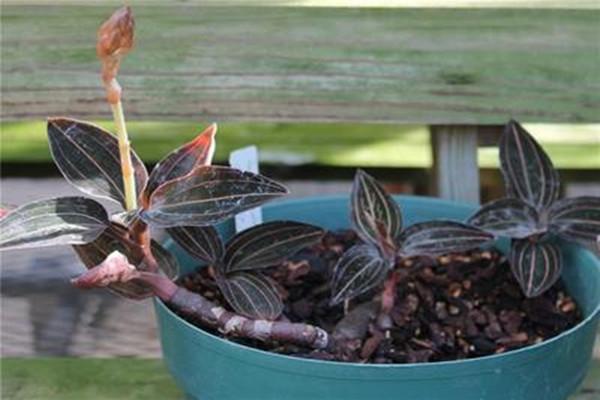
1.鞘锈菌
它通常都是发生在叶子的上下表面,也有很少的会在茎上面出现凸起的小疱,里面有着黄色、橙色、锈色或者甚至是紫黑色的粉状孢子。其实上,锈病根本就不会致命的,叶子也不会死掉的,但是却会让它的植株生长开始变得衰弱。一般防治方法就是可以把它的病叶给剪去了,另外还可以用一些化学药物进行喷洒。

2.白绢病
这个病一般都是发生在霉雨的季节。刚开始发病的时候,叶子基部上面会长满了白色的茵丝,还会让它的根茎全部烂掉。那我们一般防治的办法就是,将带有菌的花盆和土壤去掉,再撒上一些石灰。如果想要根治的话,就必须要注意多通风,盆土里的排水性也要好,如果发病严重的话,就要把那些病株给烧毁了。
3.炭疽病
这种病一般一年到头都是有的,在温度比较高或者是多余的季节更加的厉害。它一般刚开始先从叶子尖向根茎的地方开始延伸下去,颜色最初是褐色的,然后就会慢慢的扩大增多了,叶面上长黑点斑,严重的时候就可以让整个植株都死掉,那如果进行防治的话,除了要把环境条件改善一下之外,还要在发病时间内,用一些药物进行喷洒,一般每7到10天就要一次,把它给彻底跟除掉。
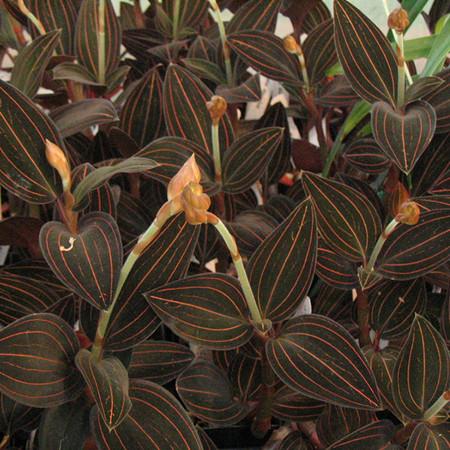
4.介壳虫
它有时候还叫做兰虱。在温度比较高和空气流动不畅的时候,这类虫害繁殖的会更加快一点,那么就会对它的植株造成很大的伤害,严重的时候也是会让它死掉的。如果数量不是很多的话,那我们就可以人工刷除掉就可以了,但是如果数量很多的话,就需要用一些化学药物了。
0
0
文章
权问薇
2018年02月05日

土里埋个塑料瓶,施肥没味不用沤!
给花施肥是个麻烦又费时费力的活,施不好还容易招虫生根,今天花花就传授给大家一个省事干净的施肥方法,肥效还相当棒哦!
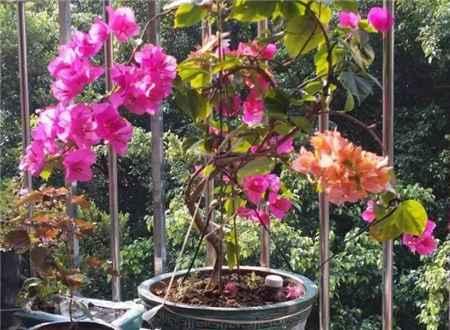
操作步骤:
1.找一个矿泉水瓶,不要太长,小型的矿泉水瓶即可,也不要太宽,直径不能超过花盆直径的1/6。

2.如图,用锋利的剪刀,把矿泉水瓶的底部,剪下一圈来。

3.把去掉底儿的矿泉水瓶,埋进花盆盆土里,注意,矿泉水瓶沿着花盆边沿埋,不要接触花卉根系,不然容易阻碍花卉根系生长,还容易烧根。
4.打开矿泉水瓶盖子,可以把平时吃剩的水果皮、摘下来的烂菜叶,切成成小碎块,扔进去,然后再把盖子拧紧,这样里面的烂菜叶、水果皮,就能在里面发酵了。
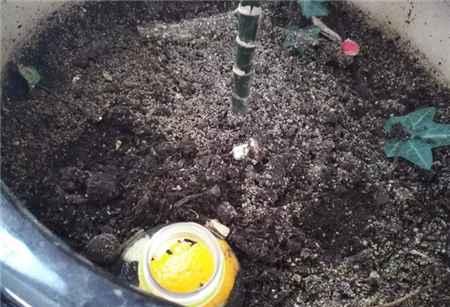
5.因为有塑料瓶保护,沤肥过程中不会直接接触根系,伤不了根系。2-3个月后,最先扔进去的果皮、菜叶,完全腐熟后,就能给花儿补充养分了。而后来扔进去的,则会留在上层继续发酵。

6.用这种方法,给盆栽花卉施肥,不仅不会烧根,而且非常干净,不会招小虫子,不会有异味,实在担心瓶子里面会生虫,可以往里面喷点杀虫剂或扔几粒呋喃丹。
1个月不浇水,花儿依旧翠绿水灵灵!
好多花友特别怕逢年过节,或者工作出差,因为家里的花十天半月没人浇水,回家一看花全部干死,欲哭无泪!去年老花农就告诉了花花一个自动浇水方法,去年试了一下,回家过年1个月,回来花儿依旧青葱翠绿,特别精神!

操作步骤:
1.找一个塑料洗脸盆,稍微大一点。

2.准备几不漏水的密封袋或者塑料袋,并把袋子里装满清水,扎紧口。
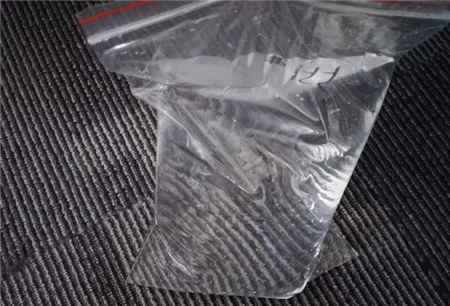
3.把仙客来、绿萝、白掌、铜钱草等喜水花卉,连花带盆放进洗脸盆里。

4.把盛满水的塑料袋,放进洗脸盆里,装水塑料袋的数量,可以根据不在家的时间长短调节,如果只是半月不在家,可以放1个,如果1个月不在家,可以放2个,一面一个。

5.用针在塑料袋上,轻轻扎2-3个孔洞,孔不要太大,让流出来的水流就尽量缓慢,不要太急!
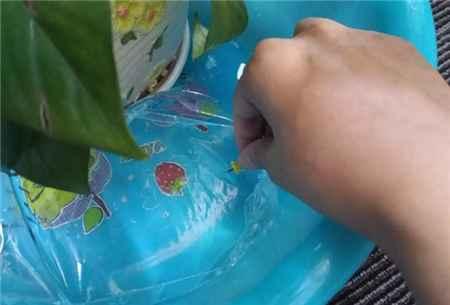
6.通过塑料袋孔洞流出来的水,会缓慢地通过花盆的透水孔,渗入到花盆底部,让根系半个甚至一个月,都能吸收到水分,而且因为孔洞小,水流缓慢,不会积水,造成根系腐烂。

泡沫箱自制温室,天再冷花儿也冻不死!
最近全国各地普遍降雪,温度下降,好多花友家的花,都被冻伤甚至冻死,好心痛!虽然痛,但大家绝对不能放弃治疗,赶紧按照下面的方法,用泡沫箱给花儿搭建个小暖棚,天儿再冷也不怕把花冻坏!
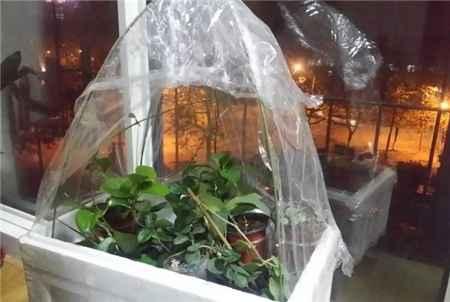
1.买海鲜、水果或者电器的时候,都会有泡沫箱,不要扔掉,挑完整的留下来,如果家里没有,可以去水果摊买几个。
2.准备几圈铁丝或者铅丝,先比着泡沫箱的宽度,用铁丝做2个弧形,每个弧形中间绕1个小圆圈。弧形两端则分别插入泡沫箱的4个角,然后拿胶带缠几圈,固定起来。
3.截一段直的铁丝,在弧形铁丝的中间小环穿过,然后互相扣紧。

4.找一块塑料薄膜,或者一个大的塑料袋,盖在我们搭建的铁丝架上,用皮筋或者胶带缠住。
5.在薄膜两边,适当开个小缝,利于通风,然后把花一盆盆,放进小暖棚里,就可以啦!如果保暖性不够,还可以在上面铺点棉衣或薄被,天儿再冷,也不怕把花冻坏啦!
6.因为每个家庭的材料、条件不同,暖棚的样式大家就根据手头的材料,自由发挥吧!
10个塑料瓶,种出全家吃的菜!
冬天的菜,好贵好贵啊,基本去趟菜市场,一两百就进去了,真肉疼!不如自己在家种点,只需10个塑料瓶,就能种出一冬天吃的菜!
1.平常喝水、喝饮料剩下的塑料瓶,不要扔掉,搜集起来,大小、直径要一致。
2.拿起第一个塑料瓶,用剪刀把瓶底剪掉!
3.把剪掉瓶底的塑料瓶倒过来,拧紧瓶盖,然后用剪刀在下图所示位置,戳几个小孔。
4.把泥炭土、珍珠岩和蛭石,按照4:1:1的比例配好,混合均匀,然后装进第一个塑料瓶里。
5.把装满土的塑料瓶,盖子朝下放在栏杆、墙壁或者铁架旁边,用胶带或者绳子固定住,不要让它倒。
6.继续把8个塑料瓶,都剪掉底部,装满土壤,注意不需要钻出水孔。
7.把剪掉底,装好土的塑料瓶,摘掉盖子,像下图一样摞在一起。
8.把摞好的8个塑料瓶,摞到第一个塑料瓶上。

9.把刚摞上去的塑料瓶,都用胶带或者绳子固定在栏杆或墙壁上。
10.取第10个塑料瓶,保留瓶盖 ,在瓶盖上打上若干小的透水孔。
11.把第10个塑料瓶,剪掉瓶底,然后倒放在最上层的塑料瓶上。
12.拿起喷水壶,往第10个塑料瓶里缓慢倒入水流。
13.这样,水流会通过第10个塑料瓶的瓶盖,逐渐往下渗透。
14.水分一层层往下渗透,直至第1个塑料瓶的土壤完全浸湿。
15.用壁纸刀,把第1-9个塑料瓶的中间位置,都切出来一个正方形小窗口,小窗口的上、左、右都切开,下方不要切。
16.最后,每个塑料瓶的中间位置,都形成了一个塑料片小开关的装置,能让小苗、种子和土不漏出来。

17.拨开塑料片,用食指往土壤里,戳一个小洞。
18.把想要种的蔬菜小苗或者种子,都种进小洞里,埋好土。
19.除了,最上层的第10个塑料瓶,用来储水、浇水,其他瓶子都像上图一样操作,种上蔬菜,完成。
20.如果菜需要浇水,直接把水倒进最上层的塑料瓶里即可,如果不想太频繁浇,也可以在上面多加1-2个储水塑料瓶。如果需要施肥, 就直接在水里加复合肥就行了!非常方便!室内不到2个月,小菜就绿油油,可以摘下来炒着吃啦!
21.以上方法做出来的小菜园,还能再自家的墙角或者定制的木架上种植,不仅种植方便,能吃上新鲜的蔬菜,而且还能形成一道靓丽的风景,为家里增添一抹绿意!
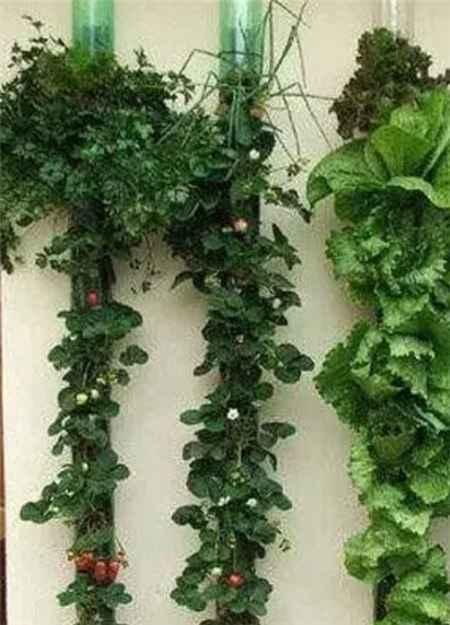
泡沫扦插法,生根分分钟!
虽然花花之前,介绍过很多很多扦插方法,但还是有好多花友跟花花抱怨,扦插好麻烦啊,扦插好难生根啊!今天花花就教大家1个超级简单的扦插方法,生根超简单哦!
1.准备一个盛水的容器,洗脸盆、缸、水箱等都可以,往里面灌水,水位最起码5厘米深。
2.找几块泡沫箱,切成若干小块,每块中间钻1-2个1厘米左右的小洞。
3.准备好扦插枝条,长寿、杜鹃、茶花、月季、栀子等所有花卉基本都可以,枝条最好提前浸泡多菌灵5-10分钟,消消毒!
4.把扦插枝条,插入到泡沫的孔洞里,然后把泡沫放到水面就可以啦!
5.把洗脸盆放在散光通风的地方,不用管就行,要想观察是否生根,直接拿起来看就可以啦~!
6.枝条生根以后,就可以把它移栽到土里,正常养护啦!
给花施肥是个麻烦又费时费力的活,施不好还容易招虫生根,今天花花就传授给大家一个省事干净的施肥方法,肥效还相当棒哦!

操作步骤:
1.找一个矿泉水瓶,不要太长,小型的矿泉水瓶即可,也不要太宽,直径不能超过花盆直径的1/6。

2.如图,用锋利的剪刀,把矿泉水瓶的底部,剪下一圈来。

3.把去掉底儿的矿泉水瓶,埋进花盆盆土里,注意,矿泉水瓶沿着花盆边沿埋,不要接触花卉根系,不然容易阻碍花卉根系生长,还容易烧根。
4.打开矿泉水瓶盖子,可以把平时吃剩的水果皮、摘下来的烂菜叶,切成成小碎块,扔进去,然后再把盖子拧紧,这样里面的烂菜叶、水果皮,就能在里面发酵了。

5.因为有塑料瓶保护,沤肥过程中不会直接接触根系,伤不了根系。2-3个月后,最先扔进去的果皮、菜叶,完全腐熟后,就能给花儿补充养分了。而后来扔进去的,则会留在上层继续发酵。

6.用这种方法,给盆栽花卉施肥,不仅不会烧根,而且非常干净,不会招小虫子,不会有异味,实在担心瓶子里面会生虫,可以往里面喷点杀虫剂或扔几粒呋喃丹。
1个月不浇水,花儿依旧翠绿水灵灵!
好多花友特别怕逢年过节,或者工作出差,因为家里的花十天半月没人浇水,回家一看花全部干死,欲哭无泪!去年老花农就告诉了花花一个自动浇水方法,去年试了一下,回家过年1个月,回来花儿依旧青葱翠绿,特别精神!

操作步骤:
1.找一个塑料洗脸盆,稍微大一点。

2.准备几不漏水的密封袋或者塑料袋,并把袋子里装满清水,扎紧口。

3.把仙客来、绿萝、白掌、铜钱草等喜水花卉,连花带盆放进洗脸盆里。

4.把盛满水的塑料袋,放进洗脸盆里,装水塑料袋的数量,可以根据不在家的时间长短调节,如果只是半月不在家,可以放1个,如果1个月不在家,可以放2个,一面一个。

5.用针在塑料袋上,轻轻扎2-3个孔洞,孔不要太大,让流出来的水流就尽量缓慢,不要太急!

6.通过塑料袋孔洞流出来的水,会缓慢地通过花盆的透水孔,渗入到花盆底部,让根系半个甚至一个月,都能吸收到水分,而且因为孔洞小,水流缓慢,不会积水,造成根系腐烂。

泡沫箱自制温室,天再冷花儿也冻不死!
最近全国各地普遍降雪,温度下降,好多花友家的花,都被冻伤甚至冻死,好心痛!虽然痛,但大家绝对不能放弃治疗,赶紧按照下面的方法,用泡沫箱给花儿搭建个小暖棚,天儿再冷也不怕把花冻坏!

1.买海鲜、水果或者电器的时候,都会有泡沫箱,不要扔掉,挑完整的留下来,如果家里没有,可以去水果摊买几个。
2.准备几圈铁丝或者铅丝,先比着泡沫箱的宽度,用铁丝做2个弧形,每个弧形中间绕1个小圆圈。弧形两端则分别插入泡沫箱的4个角,然后拿胶带缠几圈,固定起来。
3.截一段直的铁丝,在弧形铁丝的中间小环穿过,然后互相扣紧。

4.找一块塑料薄膜,或者一个大的塑料袋,盖在我们搭建的铁丝架上,用皮筋或者胶带缠住。
5.在薄膜两边,适当开个小缝,利于通风,然后把花一盆盆,放进小暖棚里,就可以啦!如果保暖性不够,还可以在上面铺点棉衣或薄被,天儿再冷,也不怕把花冻坏啦!
6.因为每个家庭的材料、条件不同,暖棚的样式大家就根据手头的材料,自由发挥吧!
10个塑料瓶,种出全家吃的菜!
冬天的菜,好贵好贵啊,基本去趟菜市场,一两百就进去了,真肉疼!不如自己在家种点,只需10个塑料瓶,就能种出一冬天吃的菜!
1.平常喝水、喝饮料剩下的塑料瓶,不要扔掉,搜集起来,大小、直径要一致。
2.拿起第一个塑料瓶,用剪刀把瓶底剪掉!
3.把剪掉瓶底的塑料瓶倒过来,拧紧瓶盖,然后用剪刀在下图所示位置,戳几个小孔。
4.把泥炭土、珍珠岩和蛭石,按照4:1:1的比例配好,混合均匀,然后装进第一个塑料瓶里。
5.把装满土的塑料瓶,盖子朝下放在栏杆、墙壁或者铁架旁边,用胶带或者绳子固定住,不要让它倒。
6.继续把8个塑料瓶,都剪掉底部,装满土壤,注意不需要钻出水孔。
7.把剪掉底,装好土的塑料瓶,摘掉盖子,像下图一样摞在一起。
8.把摞好的8个塑料瓶,摞到第一个塑料瓶上。

9.把刚摞上去的塑料瓶,都用胶带或者绳子固定在栏杆或墙壁上。
10.取第10个塑料瓶,保留瓶盖 ,在瓶盖上打上若干小的透水孔。
11.把第10个塑料瓶,剪掉瓶底,然后倒放在最上层的塑料瓶上。
12.拿起喷水壶,往第10个塑料瓶里缓慢倒入水流。
13.这样,水流会通过第10个塑料瓶的瓶盖,逐渐往下渗透。
14.水分一层层往下渗透,直至第1个塑料瓶的土壤完全浸湿。
15.用壁纸刀,把第1-9个塑料瓶的中间位置,都切出来一个正方形小窗口,小窗口的上、左、右都切开,下方不要切。
16.最后,每个塑料瓶的中间位置,都形成了一个塑料片小开关的装置,能让小苗、种子和土不漏出来。

17.拨开塑料片,用食指往土壤里,戳一个小洞。
18.把想要种的蔬菜小苗或者种子,都种进小洞里,埋好土。
19.除了,最上层的第10个塑料瓶,用来储水、浇水,其他瓶子都像上图一样操作,种上蔬菜,完成。
20.如果菜需要浇水,直接把水倒进最上层的塑料瓶里即可,如果不想太频繁浇,也可以在上面多加1-2个储水塑料瓶。如果需要施肥, 就直接在水里加复合肥就行了!非常方便!室内不到2个月,小菜就绿油油,可以摘下来炒着吃啦!
21.以上方法做出来的小菜园,还能再自家的墙角或者定制的木架上种植,不仅种植方便,能吃上新鲜的蔬菜,而且还能形成一道靓丽的风景,为家里增添一抹绿意!

泡沫扦插法,生根分分钟!
虽然花花之前,介绍过很多很多扦插方法,但还是有好多花友跟花花抱怨,扦插好麻烦啊,扦插好难生根啊!今天花花就教大家1个超级简单的扦插方法,生根超简单哦!
1.准备一个盛水的容器,洗脸盆、缸、水箱等都可以,往里面灌水,水位最起码5厘米深。
2.找几块泡沫箱,切成若干小块,每块中间钻1-2个1厘米左右的小洞。
3.准备好扦插枝条,长寿、杜鹃、茶花、月季、栀子等所有花卉基本都可以,枝条最好提前浸泡多菌灵5-10分钟,消消毒!
4.把扦插枝条,插入到泡沫的孔洞里,然后把泡沫放到水面就可以啦!
5.把洗脸盆放在散光通风的地方,不用管就行,要想观察是否生根,直接拿起来看就可以啦~!
6.枝条生根以后,就可以把它移栽到土里,正常养护啦!
2
4
文章
Miss Chen
2018年02月05日

Description: This perennial herbaceous plant is up to 3½' tall, but it is usually only 1¼–2½' tall. Smooth Ground Cherry branches frequently, creating a bushy appearance. Some of the lower branches may sprawl along the ground, otherwise they are ascending. The stems are light green or light purplish green, more or less angular, and glabrous to sparsely short-pubescent. Leaves occur throughout the length of these stems; they are alternate to nearly opposite. The leaves are up to 5" long and 3" across, although they are usually closer to one-half of this size; they are yellowish green to dark green and broadly lanceolate to oval-ovate in shape. The leaf margins are entire (toothless) and often slightly undulate; sometimes they have 1-2 shallow rounded lobes. The leaf bases are rounded and often oblique (one-half of a leaf base extending lower than the other). The upper leaf surface is glabrous or nearly so. The lower leaf surface is also glabrous or nearly so, except along the undersides of the major veins, where it is short-pubescent. Leaf venation is pinnate with slightly incurved lateral veins. The petioles are ¼–¾" long, light green, and glabrous to sparsely short-pubescent. Solitary drooping flowers develop from the axils of the middle to upper leaves, especially where the stems dichotomously branch. The slender pedicels of these flowers are ¾–1" long, light green to light purplish green, and sparsely short-pubescent.
Each flower is about ¾" long and similarly across when it is fully open, consisting of a pale yellow corolla with 5 very shallow lobes, a green calyx with 5 deltate-cordate teeth, 5 stamens with yellow or purplish yellow anthers, and a pistil. The interior of the corolla has 5 purplish brown patches that surround the reproductive organs. The calyx has 5 vertical ridges that are sparsely short-pubescent, otherwise it is glabrous. Each lobe of the corolla is slightly pointed in the middle. The blooming period occurs from mid-summer to early autumn, lasting about 1½ months. Buds, flowers, and fruits can be found simultaneously on mature plants. The flowers are replaced by husked fruits that are about 1" long, 1" across or a little less, and obcordoid-globoid in shape. The husks of these fruits are initially light green, but they later become tan-colored and papery; each husk has 10 fine vertical ridges that are light green to purple. The husks are rounded and slightly indented where they join the pedicels, while their tips are pointed. Each husk contains a single berry. At maturity, the berries are about ½" across, yellow, smooth, and globoid in shape; they have fleshy interiors that contain many seeds. The small flattened seeds are 1.5–2 mm. long and a little less across; they are pale yellow and short-reniform in shape. The root system is rhizomatous, from which clonal offsets develop.
Cultivation: The preference is full to partial sun, moist to mesic conditions, and soil consisting of fertile loam. The lower leaves may turn yellow, or the entire plant may droop, in conditions that are too dry. This weedy species is easy to grow and sometimes it becomes aggressive.
Range & Habitat: The native Smooth Ground Cherry is common in most counties of Illinois, but it is uncommon or absent in parts of southern Illinois (see Distribution Map). Habitats include disturbed areas of black soil prairies, weedy meadows, disturbed open woodlands, thickets, areas along railroads, roadsides, abandoned fields and pastures, gardens and yards, and waste ground. Areas with a history of disturbance are preferred.

Faunal Associations: Halictid bees (including green metallic bees), plasterer bees (Colletes spp.) and other short-tongued bees visit the flowers for nectar and pollen (Robertson, 1929). Some of these bees are specialist pollinators (oligoleges) of ground cherries (Physalis spp.); they include two plasterer bees, Colletes latitarsis and Colletes willistoni, and a dagger bee, Perdita halictoides. Other insects feed destructively on these plants. These insect feeders consist primarily of various leaf beetles (Chrysomelidae), including Lemma daturaphila (Three-lined Potato Beetle), Lema trivittata (Three-striped Potato Beetle), Leptinotarsa decemlineata (Colorado Potato Beetle), Leptinotarsa juncta (False Potato Beetle), Plagiometriona clavata (Clavate Tortoise Beetle), Epitrix cucumeris (Potato Flea Beetle), Epitrix fuscula (Eggplant Flea Beetle), Epitrix hirtipennis (Tobacco Flea Beetle), and other Epitrix spp. (flea beetles) that are attracted to the Solanaceae (Clark et al., 2004). Generally, the adults of these beetles feed on foliage, while the larvae feed on either roots or foliage. The larvae of some moths also feed on ground cherries. The larvae of a Noctuid moth, Heliothis subflexus (Subflexus Straw), feed on the fruits of these plants, while the larvae of Heliothis virescens (Tobacco Budworm) feed on the buds, flowers, and fruits. The larvae of two Sphinx moths, Manduca quinquemaculata (Tomato Hornworm) and Manduca sexta (Tobacco Hornworm), feed primarily on the foliage of these plants, while the larvae of a Gelechiid moth, Aristotelia physaliella, are leaf-miners (Covell, 1984/2005; Wagner, 2005; Needham et al., 1928). Some vertebrate animals eat the fruits of ground cherries, helping to spread the seeds of these plants to new locations. These fruit-eating animals include the Bobwhite Quail, Wild Turkey, Opossum, Striped Skunk, Spotted Skunk, Pine Mouse, White-footed Mouse, Eastern Box Turtle, and Ornate Box Turtle (Martin et al., 1951/1961; Ernst et al., 1994). Like other species in the Nightshade family (Solanaceae), ground cherries have foliage that is bitter-tasting and toxic. As a result, mammalian herbivores avoid its consumption.

Photographic Location: The photographs were taken at the webmaster's apartment complex in Urbana, Illinois.
Comments: The various ground cherries (Physalis spp.) can be difficult to distinguish and their taxonomy is somewhat unstable. Smooth Ground Cherry (Physalis subglabrata) is sometimes classified as a distinct species (Mohlenbrock, 2002), and sometimes it is classified as a variety of Physalis virginiana or Physalis longifolia (usually the latter). Compared to other ground cherries, Smooth Ground Cherry has wider leaves that are not significantly lobed and it tends to be a larger plant. It also has less hairy leaves and stems than many ground cherries. After their husks have been removed, the berries of wild ground cherries resemble cherry tomatoes that are yellow or red. One species, the Tomatillo (Physalis philadelphica), is sometimes cultivated as an ingredient in Mexican cuisine. In Illinois, this annual species is sometimes cultivated in gardens, from which it rarely escapes and naturalizes into uncultivated areas. Compared to Smooth Ground Cherry, Tomatillo has slightly larger and showier flowers; the anthers of Tomatillo's flowers are purplish white, rather than yellow or purplish yellow. In addition, the leaves of Tomatillo usually have sharply pointed lobes, while those of Smooth Ground Cherry either lack lobes or their lobes are rounded and shallow.
Each flower is about ¾" long and similarly across when it is fully open, consisting of a pale yellow corolla with 5 very shallow lobes, a green calyx with 5 deltate-cordate teeth, 5 stamens with yellow or purplish yellow anthers, and a pistil. The interior of the corolla has 5 purplish brown patches that surround the reproductive organs. The calyx has 5 vertical ridges that are sparsely short-pubescent, otherwise it is glabrous. Each lobe of the corolla is slightly pointed in the middle. The blooming period occurs from mid-summer to early autumn, lasting about 1½ months. Buds, flowers, and fruits can be found simultaneously on mature plants. The flowers are replaced by husked fruits that are about 1" long, 1" across or a little less, and obcordoid-globoid in shape. The husks of these fruits are initially light green, but they later become tan-colored and papery; each husk has 10 fine vertical ridges that are light green to purple. The husks are rounded and slightly indented where they join the pedicels, while their tips are pointed. Each husk contains a single berry. At maturity, the berries are about ½" across, yellow, smooth, and globoid in shape; they have fleshy interiors that contain many seeds. The small flattened seeds are 1.5–2 mm. long and a little less across; they are pale yellow and short-reniform in shape. The root system is rhizomatous, from which clonal offsets develop.
Cultivation: The preference is full to partial sun, moist to mesic conditions, and soil consisting of fertile loam. The lower leaves may turn yellow, or the entire plant may droop, in conditions that are too dry. This weedy species is easy to grow and sometimes it becomes aggressive.
Range & Habitat: The native Smooth Ground Cherry is common in most counties of Illinois, but it is uncommon or absent in parts of southern Illinois (see Distribution Map). Habitats include disturbed areas of black soil prairies, weedy meadows, disturbed open woodlands, thickets, areas along railroads, roadsides, abandoned fields and pastures, gardens and yards, and waste ground. Areas with a history of disturbance are preferred.

Faunal Associations: Halictid bees (including green metallic bees), plasterer bees (Colletes spp.) and other short-tongued bees visit the flowers for nectar and pollen (Robertson, 1929). Some of these bees are specialist pollinators (oligoleges) of ground cherries (Physalis spp.); they include two plasterer bees, Colletes latitarsis and Colletes willistoni, and a dagger bee, Perdita halictoides. Other insects feed destructively on these plants. These insect feeders consist primarily of various leaf beetles (Chrysomelidae), including Lemma daturaphila (Three-lined Potato Beetle), Lema trivittata (Three-striped Potato Beetle), Leptinotarsa decemlineata (Colorado Potato Beetle), Leptinotarsa juncta (False Potato Beetle), Plagiometriona clavata (Clavate Tortoise Beetle), Epitrix cucumeris (Potato Flea Beetle), Epitrix fuscula (Eggplant Flea Beetle), Epitrix hirtipennis (Tobacco Flea Beetle), and other Epitrix spp. (flea beetles) that are attracted to the Solanaceae (Clark et al., 2004). Generally, the adults of these beetles feed on foliage, while the larvae feed on either roots or foliage. The larvae of some moths also feed on ground cherries. The larvae of a Noctuid moth, Heliothis subflexus (Subflexus Straw), feed on the fruits of these plants, while the larvae of Heliothis virescens (Tobacco Budworm) feed on the buds, flowers, and fruits. The larvae of two Sphinx moths, Manduca quinquemaculata (Tomato Hornworm) and Manduca sexta (Tobacco Hornworm), feed primarily on the foliage of these plants, while the larvae of a Gelechiid moth, Aristotelia physaliella, are leaf-miners (Covell, 1984/2005; Wagner, 2005; Needham et al., 1928). Some vertebrate animals eat the fruits of ground cherries, helping to spread the seeds of these plants to new locations. These fruit-eating animals include the Bobwhite Quail, Wild Turkey, Opossum, Striped Skunk, Spotted Skunk, Pine Mouse, White-footed Mouse, Eastern Box Turtle, and Ornate Box Turtle (Martin et al., 1951/1961; Ernst et al., 1994). Like other species in the Nightshade family (Solanaceae), ground cherries have foliage that is bitter-tasting and toxic. As a result, mammalian herbivores avoid its consumption.

Photographic Location: The photographs were taken at the webmaster's apartment complex in Urbana, Illinois.
Comments: The various ground cherries (Physalis spp.) can be difficult to distinguish and their taxonomy is somewhat unstable. Smooth Ground Cherry (Physalis subglabrata) is sometimes classified as a distinct species (Mohlenbrock, 2002), and sometimes it is classified as a variety of Physalis virginiana or Physalis longifolia (usually the latter). Compared to other ground cherries, Smooth Ground Cherry has wider leaves that are not significantly lobed and it tends to be a larger plant. It also has less hairy leaves and stems than many ground cherries. After their husks have been removed, the berries of wild ground cherries resemble cherry tomatoes that are yellow or red. One species, the Tomatillo (Physalis philadelphica), is sometimes cultivated as an ingredient in Mexican cuisine. In Illinois, this annual species is sometimes cultivated in gardens, from which it rarely escapes and naturalizes into uncultivated areas. Compared to Smooth Ground Cherry, Tomatillo has slightly larger and showier flowers; the anthers of Tomatillo's flowers are purplish white, rather than yellow or purplish yellow. In addition, the leaves of Tomatillo usually have sharply pointed lobes, while those of Smooth Ground Cherry either lack lobes or their lobes are rounded and shallow.
0
0
文章
Miss Chen
2018年02月05日

Description: This perennial plant is 1½–2½' tall, branching frequently. The stems are usually round and covered with white hairs. The alternate leaves are whitish or yellowish green, and up to 4" long and 3" across. They are cordate or broadly lanceolate, with a well-rounded base. The leaf margins are horizontally wavy and irregular, and often undulate vertically as well. Both the leaves and their petioles are covered with fine white hairs, and have a rather soft texture. These hairs are sometimes glandular. A single drooping flower appears at the juncture of two divergent stems. It is up to ¾" across, and consists of a spreading tubular corolla that is pale yellow and divided into 5 very shallow lobes. There are 5 brownish purple splotches near the base of the corolla and 5 prominent dull yellow anthers. The pedicels of the flowers exceed 1/5" when fully developed, while the calyx has triangular teeth; they are both covered with fine white hairs. Later, the flowers are replaced by heart-shaped husks that are up to ¾" long, each containing a single fruit. The husk of the fruit is initially green, but later turns brown, and is indented at the base. The spherical fruit is about ½" across and becomes yellow when mature. It contains numerous light brown seeds that are elliptical and granular. On a typical mature plant during the summer, there are several buds, flowers, and husked fruit in all stages of development. The blooming period occurs during the summer and lasts about 2 months. The root system consists of deep fleshy rhizomes, which spread the plant vegetatively.
Cultivation: The preference is full or partial sun, and slightly moist to dry conditions. The soil can contain substantial portions of loam, sand, or gravel. This plant often thrives in sterile soil, or disturbed areas with rich soil, because this reduces competition from taller, more aggressive plants. It is fairly drought tolerant.
Range & Habitat: Clammy Ground Cherry occurs throughout most of Illinois, except some of the south-central and north-central counties (see Distribution Map). This plant is native to Illinois. It can be found occasionally in mesic to dry black soil prairies, especially in disturbed areas. This plant also occurs in openings of rocky or sandy upland forests, sand prairies, abandoned fields and pastures, areas along roadsides and railroads, and various waste areas.

Faunal Associations: Short-tongued bees collect pollen or suck nectar at the flowers. This includes the Plasterer bees Colletes latitarsis and Colletes willistoni, and some Halictine and Panurgine bees. The caterpillars of the moth Heliothis subflexus (Subflexus Straw) eat the fruit of this plant, while other insects feed on or suck juices from the foliage, including Paratrioza cockerellii (Potato Psyllid), Macrosiphum euphorbiae (Potato Aphid), and Lema trilineata (Leaf Beetle sp.). Mammalian herbivores usually don't eat this plant because the poisonous leaves and unripe fruit contain significant amounts of solanum. There has been cases of cattle being poisoned by this species and other ground cherries. Various upland gamebirds and small mammals eat the mature fruit and help to distribute the seeds, including the Bobwhite Quail, Ring-Necked Pheasant, Wild Turkey, Eastern Striped Skunk, and White-Footed Mouse

Photographic Location: The above photographs were taken at the edge of a prairie remnant near a cultivated field in Champaign County, Illinois. This prairie remnant occurred along a railroad.
Comments: This plant has a very different appearance from Physalis subglabrata (Smooth Ground Cherry). The most striking features of Clammy Ground Cherry are the abundance of fine white hairs on the foliage and the irregular shape of the rather large leaves. Different varieties of this species have been described. It is probably one of the two most common ground cherries in Illinois, preferring areas that are sunny and on the dry side. The mature yellow fruit is edible to humans.
Cultivation: The preference is full or partial sun, and slightly moist to dry conditions. The soil can contain substantial portions of loam, sand, or gravel. This plant often thrives in sterile soil, or disturbed areas with rich soil, because this reduces competition from taller, more aggressive plants. It is fairly drought tolerant.
Range & Habitat: Clammy Ground Cherry occurs throughout most of Illinois, except some of the south-central and north-central counties (see Distribution Map). This plant is native to Illinois. It can be found occasionally in mesic to dry black soil prairies, especially in disturbed areas. This plant also occurs in openings of rocky or sandy upland forests, sand prairies, abandoned fields and pastures, areas along roadsides and railroads, and various waste areas.

Faunal Associations: Short-tongued bees collect pollen or suck nectar at the flowers. This includes the Plasterer bees Colletes latitarsis and Colletes willistoni, and some Halictine and Panurgine bees. The caterpillars of the moth Heliothis subflexus (Subflexus Straw) eat the fruit of this plant, while other insects feed on or suck juices from the foliage, including Paratrioza cockerellii (Potato Psyllid), Macrosiphum euphorbiae (Potato Aphid), and Lema trilineata (Leaf Beetle sp.). Mammalian herbivores usually don't eat this plant because the poisonous leaves and unripe fruit contain significant amounts of solanum. There has been cases of cattle being poisoned by this species and other ground cherries. Various upland gamebirds and small mammals eat the mature fruit and help to distribute the seeds, including the Bobwhite Quail, Ring-Necked Pheasant, Wild Turkey, Eastern Striped Skunk, and White-Footed Mouse

Photographic Location: The above photographs were taken at the edge of a prairie remnant near a cultivated field in Champaign County, Illinois. This prairie remnant occurred along a railroad.
Comments: This plant has a very different appearance from Physalis subglabrata (Smooth Ground Cherry). The most striking features of Clammy Ground Cherry are the abundance of fine white hairs on the foliage and the irregular shape of the rather large leaves. Different varieties of this species have been described. It is probably one of the two most common ground cherries in Illinois, preferring areas that are sunny and on the dry side. The mature yellow fruit is edible to humans.
0
0
文章
Miss Chen
2018年02月05日

Description: This perennial plant is 1-3' tall and usually unbranched. The central stem is terete, smooth, and usually glabrous; it also has numerous purple spots or streaks. The opposite leaves are medium to dark green, often with a shiny upper surface, and they are sessile against the stem or nearly so. They are about 2½-4" long and ½-¾" across. The leaves are narrowly lanceolate to lanceolate in shape and smooth along their margins; they are widest near their bases, while their tips are long and slender. Both the upper and lower surfaces of the leaves are glabrous. The central stem terminates in a panicle of flowers that is about 3-8" in length and longer than it is wide. The panicle of the typical subspecies (ssp. maculata) is cylindrical in shape (see Panicle Photo), while the panicle of spp. pyramidalis is pyramidal in shape (broader at the base than toward the apex). Individual flowers are about ¾" across, consisting of a pink, purple, or white corolla with 5 petal-like lobes, a green to purplish green calyx with 5 linear lobes (about ¼" in length), and the reproductive organs. The base of the corolla is narrowly tubular, while its petal-like lobes are obovate in shape. The calyx is shorter than the corolla and usually glabrous. The slender pedicels of the flowers are short (less than ½" in length). The blooming period occurs during the summer, lasting about 1-2 months. After the flowers wither away, they are replaced by ovoid seed capsules about 1/3" (8 mm.) in length. These capsules are 3-celled, and each cell of a capsule contains one or more seeds. The small seeds are distributed by the wind to a limited extent. The root system consists of a taproot.
Cultivation: Preferred habitat consists of full sun to light shade, moist conditions, and soil containing silt, loam, or sandy loam. There should be sufficient organic material to retain moisture. After flowering, this plant tends to die down. If conditions are not right, it can be short-lived.
Range & Habitat: The native Speckled Phlox occurs in scattered counties in the northern half of Illinois (see Distribution Map). It is an uncommon plant in the wild. Some populations may be plants that have escaped cultivation, as it is a popular garden plant. Habitats include bottomland woodlands, woodland openings, moist meadows along rivers, banks of rivers, fens, roadsides in wooded areas, and abandoned fields. Speckled Phlox typically occurs near woodlands or sources of water, rather than open prairie.

Faunal Associations: The flowers are cross-pollinated by nectar-seeking butterflies, skippers, and moths. Small Syrphid flies may eat the pollen of the flowers, but they are non-pollinating. Caterpillars of the moth Heliothis turbatus (Spotted Straw) feed destructively on the flowers and buds, while caterpillars of the moth Lacinipolia olivacea (Olive Arches) feed on the foliage. Some plant bugs suck the juices of Speckled Phlox and other Phlox spp., including Lopidea davisi (Phlox Scarlet Plant Bug) and Poecilocapsus lineatus (Four-Lined Plant Bug). The larvae of a long-horned beetle, Oberea flavipes, bore through the stems. Mammalian herbivores readily consume Speckled Phlox, including rabbits, groundhogs, and deer. It can be difficult to maintain populations of this uncommon plant when these animals are abundant.

Photographic Location: The photographs were taken at a flower garden along a sidewalk in Urbana, Illinois.
Comments: This is another lovely Phlox species (Phlox sp.) that is uncommonly encountered in the wild. Wild plants with white flowers, in particular, are quite rare. Speckled Phlox can be distinguished from other Phlox spp. in Illinois by its purple-spotted stems and elongated panicles of flowers. Unlike Speckled Phlox, other Phlox spp. within the state have panicles of flowers that are wider than they are tall. The photographed plant is a cultivar with white flowers, but it has features that are typical of wild plants. Its cylindrical panicle of flowers is a key characteristic of the typical subspecies, Phlox maculata maculata. Other common names of this plant include Spotted Phlox, Meadow Phlox, and Wild Sweet William.
Cultivation: Preferred habitat consists of full sun to light shade, moist conditions, and soil containing silt, loam, or sandy loam. There should be sufficient organic material to retain moisture. After flowering, this plant tends to die down. If conditions are not right, it can be short-lived.
Range & Habitat: The native Speckled Phlox occurs in scattered counties in the northern half of Illinois (see Distribution Map). It is an uncommon plant in the wild. Some populations may be plants that have escaped cultivation, as it is a popular garden plant. Habitats include bottomland woodlands, woodland openings, moist meadows along rivers, banks of rivers, fens, roadsides in wooded areas, and abandoned fields. Speckled Phlox typically occurs near woodlands or sources of water, rather than open prairie.

Faunal Associations: The flowers are cross-pollinated by nectar-seeking butterflies, skippers, and moths. Small Syrphid flies may eat the pollen of the flowers, but they are non-pollinating. Caterpillars of the moth Heliothis turbatus (Spotted Straw) feed destructively on the flowers and buds, while caterpillars of the moth Lacinipolia olivacea (Olive Arches) feed on the foliage. Some plant bugs suck the juices of Speckled Phlox and other Phlox spp., including Lopidea davisi (Phlox Scarlet Plant Bug) and Poecilocapsus lineatus (Four-Lined Plant Bug). The larvae of a long-horned beetle, Oberea flavipes, bore through the stems. Mammalian herbivores readily consume Speckled Phlox, including rabbits, groundhogs, and deer. It can be difficult to maintain populations of this uncommon plant when these animals are abundant.

Photographic Location: The photographs were taken at a flower garden along a sidewalk in Urbana, Illinois.
Comments: This is another lovely Phlox species (Phlox sp.) that is uncommonly encountered in the wild. Wild plants with white flowers, in particular, are quite rare. Speckled Phlox can be distinguished from other Phlox spp. in Illinois by its purple-spotted stems and elongated panicles of flowers. Unlike Speckled Phlox, other Phlox spp. within the state have panicles of flowers that are wider than they are tall. The photographed plant is a cultivar with white flowers, but it has features that are typical of wild plants. Its cylindrical panicle of flowers is a key characteristic of the typical subspecies, Phlox maculata maculata. Other common names of this plant include Spotted Phlox, Meadow Phlox, and Wild Sweet William.
0
0




